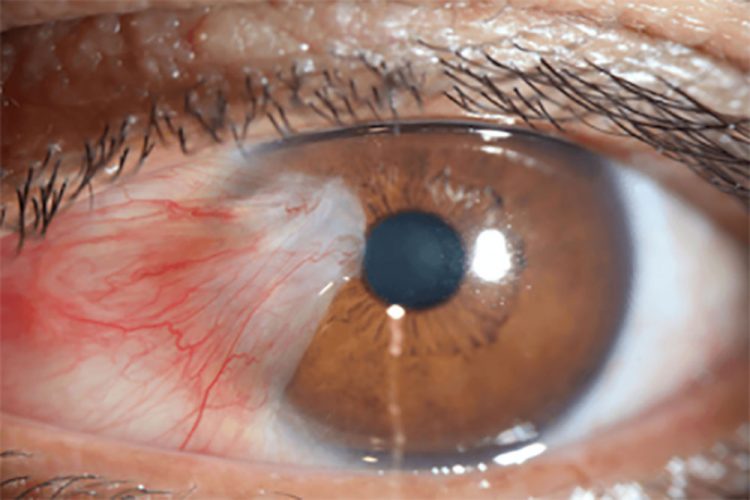What is a Pterygium and how is it treated?

Wellie’s grandmother had beautiful eyes, or so Wellie thought. They were a mixture of brown, grey and green and depending on how the light fell, they would change colour.
When Wellie returned from college after a three-year stint, she went to visit her grandmother. She was greeted at the door.
Wellie noticed it immediately. Something had changed. There was something wrong with Grandma’s lovely eyes.
She looked closer. It was as if a thin film was covering a part of the eye.
Wellie picked up the phone and called me. “Doc, I need your help, something is going on with Grandma”. I listened for a minute and then told her: “Please come in to see me tomorrow, I believe it may be a growth on her eyes.
She promptly arrived the next day with her granny in tow.
I explained to both Wellie and her granny that the confirmed growth was a pterygium.
Let me explain…
What is a Pterygium
A pterygium is an abnormal piece of flesh, usually triangular in shape, that grows on the eyeball and slowly extends onto the cornea of the eye.
It is not cancerous, however, if the growth continues, it can interfere with vision.
A Pterygium is not to be mistaken for a cataract. A cataract is a cloudiness of the natural lens of the eye and is located INSIDE the eye.
A Pterygium is a growth ON the OUTER SURFACE of the eyeball.
What causes Pterygium?
People who live under extreme dry, dusty and sunny conditions are more prone to have pterygia (plural for pterygium).
This is especially so for people who spend a lot of time outdoors.
Ultraviolet light exposure and windy conditions are known to be causes of pterygia.
Symptoms Of Pterygium
If the pterygium is small, there may be hardly any symptoms, but if they grow bigger or larger they can cause an unevenness on the eyeball that feels like a foreign body when blinking.
The normal tear film cannot coat the eye evenly, causing further dryness and oftentimes a gritty or sandy feeling in the eye.
If left to grow on the cornea too long, pterygia tend to induce astigmatism, as they can change the shape of the cornea.
This makes correction with glasses extremely difficult.
How are Pterygia treated?
Surgical excision of the pterygium is usually indicated if the pterygium has crossed over at least one third of the cornea, or if it interferes with your vision.
Also, if you have a pterygium and want to wear contact lenses, it will have to be removed to facilitate the fitting of the contact lens.
Sometimes even small pterygias are removed if they cause extreme discomfort or are repeatedly inflamed. Some people elect to have them removed for cosmetic reasons.
It must be said that fewer than 1/3 of all pterygia have a tendency to recur. In such cases a different surgical approach is indicated.
If however the pterygium is not causing any problems and there are none of the symptoms previously mentioned, then surgery is not necessary.
Most surgeons seek to divert the direction of the blood vessels in the area of the excised pterygium, sometimes using sutures in order to change direction of conjunctival tissue away from the cornea.
In cases of recurrence, it is not uncommon for surgery to be repeated. This time a conjunctival graft is preferred. Healthy conjunctival tissue is taken from another area of the eye and is used to cover the area of excised pterygium.
There are different types of surgical methods, some also include the use of mitomycin, an anti-cancer drug that disables the cells in the area of excision, reducing the rate of recurrence.
Some surgeons prefer to glue new tissue to the excised area and the cornea is usually polished to remove any residue.
A local anesthetic is applied to the eye so that no pain is felt. The eye is kept open using an eyelid speculum, making access to the eye easy.
The surgery is usually over in less than 15 minutes. Ointment is applied, and the eye is patched for a day or two.
Lubricating drops are prescribed, and the patient can resume normal activity nearly immediately or within a few days.
If sutures are used they are removed several days later.
Patients are advised to use glasses or sunglasses and lubricating eye drops, as they help prevent recurrence by protecting the eyes from Ultraviolet light exposure, wind and dust.
Remember To Keep An Eye On Your Eyes
Wellie‘s grandmother had surgery to excise the pterygium.
She is healing well and will soon get a pair of tinted glasses to upgrade her vision and to protect her eyes from dust and ultraviolet light.
She is also using artificial tears to lubricate and moisten her eyes.
Her beautiful eyes have returned, and Wellie is a happy camper again.










